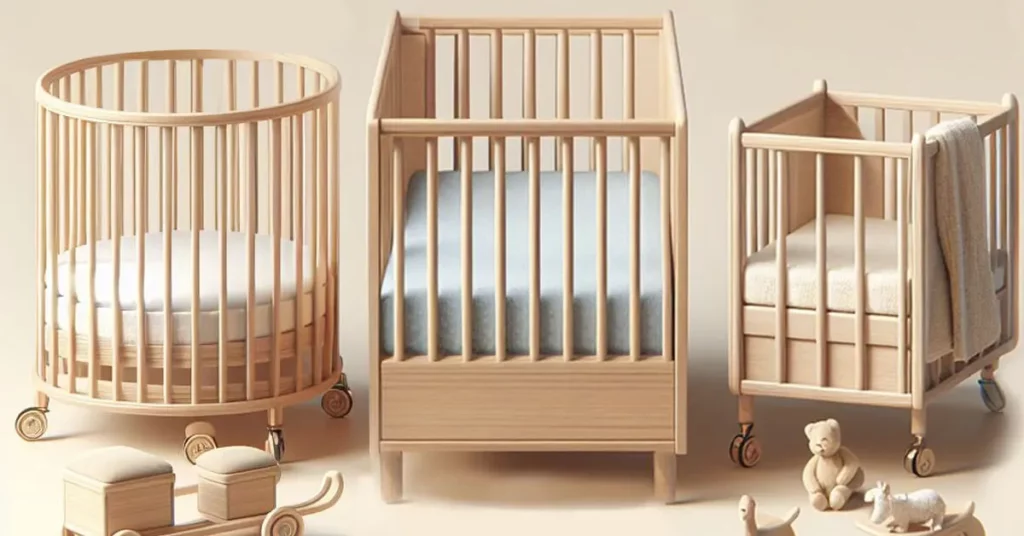
Today, I am going to help you navigate the different types of baby cribs. Buying a crib isn’t just about picking a resting place for your little one. A crib is a space where your baby will spend a significant amount of time, so it has to be safe and comfortable for them and practical for you.
The market offers many different types of cribs, each with specific features and benefits. I will list and describe each type, ensuring you have the information necessary to make the right choice.
The right crib can make a big difference in your daily life as a parent. So, how do you know which crib type is best for your needs?
You will find out soon. But first, I want to stress an important point. The best option isn’t always the most expensive or the trendiest—it’s the one that aligns with your family’s unique situation.
Different Types of Baby Cribs Detailed
Each crib type serves a unique need, and knowing your priorities is key. So, let’s look at the different crib types and their distinctive features, ideal uses, and to whom each type best suits.
1. Standard Cribs:
These are the traditional, no-frills options that come to mind when you think of baby cribs. They have four fixed sides and a sturdy frame, making them a reliable choice.
This type of crib is very rare on the market nowadays, as parents usually want more from a crib. However, if simplicity and tradition are your top priorities, then this is one you can also consider.
2. Convertible Cribs:
These are the long-term players in the crib world. With the capability to transform into toddler beds, daybeds, and sometimes even full-sized beds, these cribs adapt as your child grows.
If you’re after a one-time purchase that lasts for years, this is your go-to. However, you have to consider that most crib brands sell convertible kits separately. In any case, this is still a money saver because you do not need to buy new beds every few years.
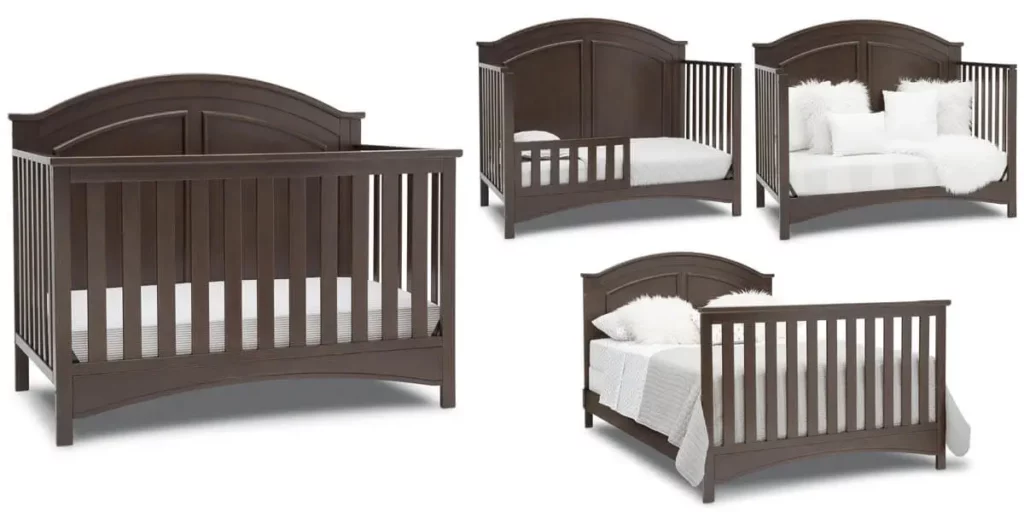
3. Multifunctional Cribs:
These cribs provide more than just sleeping space; they also come with attached changing tables, drawers, and shelves. These are convertible cribs that may have a drawer underneath the whole mattress’s area or/and an attached changing table with drawers and shelves.
If you have limited space or love the idea of an all-in-one solution, these cribs could be a perfect choice.
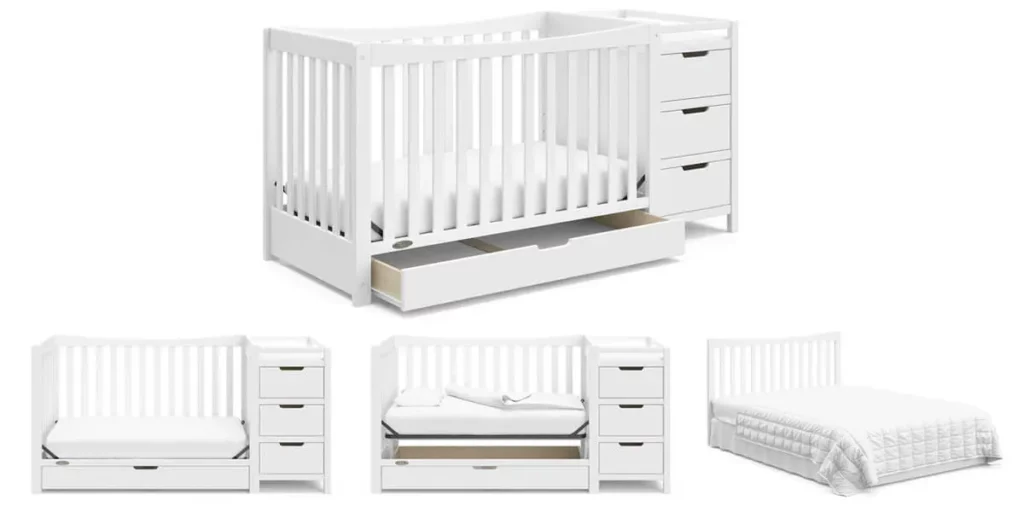
4. Portable Cribs:
Often made to be slightly smaller than standard cribs, these come with wheels for easy mobility around the home. These are wooden or metal cribs on wheels. Some models have a folding mechanism, so you can fold them flat when they are not in use.
A portable crib is a smart choice if you want the flexibility to move your baby’s sleeping area from one room to another.
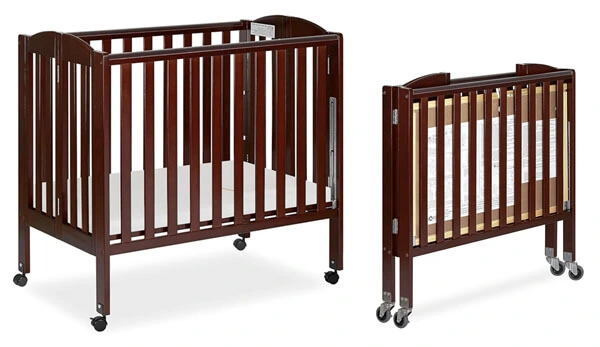
5. Mini Cribs and Round Cribs:
Mini cribs and round cribs offer unique solutions for small spaces and aesthetic preferences. Mini cribs are smaller versions of convertible, multifunctional, and portable cribs. They maintain the same functionality and versatility but in a more compact size, making them ideal for apartments or nurseries with limited space. Round cribs, on the other hand, provide a distinct, stylish look with their circular design. They can also be convertible and portable.
6. Playards (Pack ‘N Plays):
Playards (also called Pack ‘N Plays) are multifunctional baby gear that can be used as an everyday or travel crib, secure playing area, and place for naps.
They are made of a plastic or aluminum frame surrounded by mesh. Some models come with accessories like a newborn bassinet, crib mobiles, storage units, etc.
Playards are also collapsible and portable, making them a great secondary option for many families.

7. Travel Cribs:
Travel cribs are lightweight, foldable, and easy to pack, ensuring your little one has a familiar sleeping space wherever you go.
Like Playards, travel cribs are made of a light plastic or aluminum frame surrounded by breathable mesh. However, these are even lighter and usually smaller. Another thing that sets them apart from Playards is their narrower top and mattress placed on the floor.
Travel cribs offer the ultimate convenience for families that are always on the move. However, unlike Pack ‘N Plays, they cannot substitute for a regular crib for everyday use.
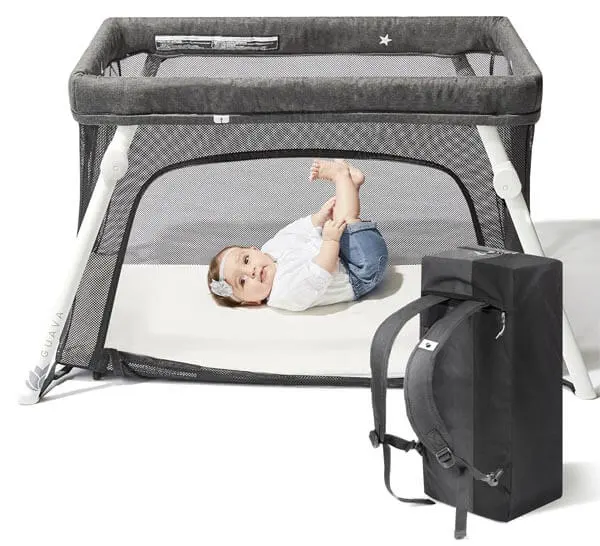
8. Bassinets:
Bassinets, while not technically cribs, are designed and approved as safe sleep spaces for newborns. These small, portable beds are a perfect choice for the early months, providing a cozy and secure environment for your baby. Bassinets are lightweight and easy to move from room to room, allowing you to keep your newborn close during naps and nighttime sleep.
How Do You Decide on the Right Crib Type?
Choosing a crib isn’t just about design or style; it’s also about practicality and safety. When you’re standing in the store or browsing online, the myriad of options can seem overwhelming. Thus, I will explain what you need to consider so that you can pick a crib type that fits your family’s needs.
1. Space in Your Nursery:
First, look at the space you have in your baby’s room. It’s one thing to fall in love with a grand convertible crib, but quite another to actually fit it into a nursery.
Furthermore, remember that not only the size but also the crib’s shape affects how it fits into the room. Think about how the crib will influence room layout and functionality, and choose a crib that allows for easy movement around the room.
2. Are you buying for a long run
Now, let’s talk about your baby and their growth. Tiny babies don’t stay tiny for long, and buying a crib is usually a long-term investment. Consider convertible cribs that can change into toddler beds or even go as far as to become full-size beds. This way, you’re not just prepping for the infant stage, but setting up for future transitions without needing to shop for new furniture every few years.
3. How much money are you willing to spend?
Budget is crucial, and I’m here to tell you that more expensive doesn’t always mean better. Your top concern should be safety. Every crib you consider must meet current safety standards – this includes sturdy construction, non-toxic finishes, and slats that are a safe distance apart.
The good news is there are choices across various price points that don’t cut corners on safety.
4. Ease of Use:
With safety in constant focus, also consider ease of use and features such as adjustable mattress heights, which can be a game-changer as your child grows. Look for a crib that makes it easy to change bedding and has secure, child-proof mechanisms. Many parents appreciate the convenience of teething rails and wheeled legs for easy room rearrangement as well.
Comparison of Different Types of Baby Cribs
I created a comparison chart to help you understand the differences between various types of cribs. This user-friendly chart covers standard cribs, convertible cribs, portable cribs, multifunctional cribs, travel cribs, and Pack ‘N Plays. It highlights their key features, advantages, and disadvantages, and shows which crib type is best for different needs.
| Crib Type | Key Features | Advantages | Disadvantages | Best for |
|---|---|---|---|---|
| Standard Cribs | – Fixed sides – Sturdy construction – Full-size | – Sturdy and stable | – Not portable or convertible – Can be expensive | Those who like stable, traditional cribs. |
| Convertible Cribs | – Converts into toddler bed, daybed, or full-size bed – Multiple configurations – Mini and full-size | – Long-term use – Cost-effective in the long run – Versatile | – Higher initial cost – Requires additional parts for conversion | Families looking to maximize value and longevity from their crib purchase. |
| Portable Cribs | – Wheels for mobility – Foldable or collapsible – Mini and full-size | – Easy to move and store – Great for small spaces – Often lightweight | – Less sturdy than standard or convertible cribs – Limited weight/age capacity | Great for small living spaces or for those who need to move the crib frequently within the home. |
| Multifunctional Cribs | – Combines crib with changing table, drawers, or shelving | – Space-saving – Combines multiple pieces of furniture – Convenient | – Bulky – More expensive – Limited configuration options once set up | Families looking to optimize nursery space without compromising functionality. |
| Travel Cribs | – Lightweight – Foldable or collapsible – Easy to assemble | – Highly portable – Great for travel – Easy to set up and pack down | – Less durable – Limited features – Smaller size may not suit older babies | Frequent travelers or those needing a crib for occasional use outside the home. |
| Pack ‘N Plays | – Versatile – Can include a bassinet, changing station, storage – Portable | – Multipurpose – Great for travel and use at home – Often has wheels | – Can be bulky when fully assembled – Not as sturdy as standard or convertible cribs | Families needing a multipurpose solution that is easy to transport and set up. |
Conclusion: Selecting Your Baby’s Crib with Confidence
Buying a crib isn’t just about buying furniture; it’s about creating a safe, comfortable, and nurturing environment for your little one.
When you search through different crib types, consider not only the aesthetics but also how the crib’s functionality aligns with your everyday life. And remember, at the end of the day, the crib is a tool to ensure your baby’s safe and comfortable sleep, not a decorative element in your home.
Choose something that resonates with your lifestyle and child-rearing philosophy. A portable crib can be a great choice if mobility is a priority for you, while a convertible crib might suit you if longevity is what you’re looking for.
So, my question today is, have you considered all your needs and conditions? If you’re still unsure, you can read our guide on how to choose a crib. You can also reach out to other parents or consult with a child-care specialist. They’re often a treasure trove of helpful advice.
I really hope that this guide helps you navigate the crowded market of different crib types. With the right information and a clear sense of your needs, I’m confident you’ll find the perfect one for your needs. Feel free to come back to this guide or reach out if you have more questions.
